Burmese cat
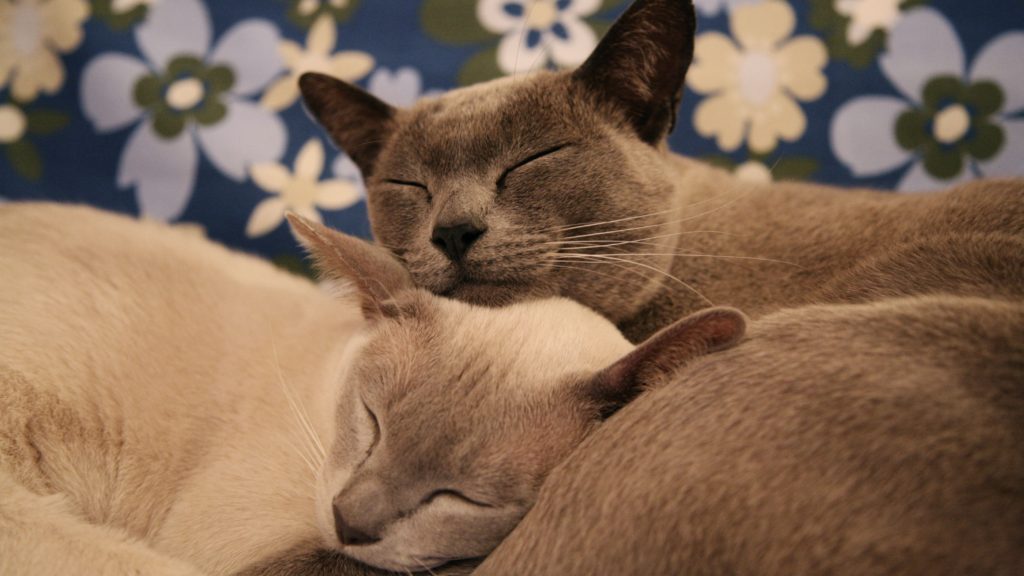
The Burmese cat is a breed of domestic cat, originating in Thailand or Myanmar, believed to have its roots near the present Thai-Burma border and developed in the United States and Britain.
Most modern Burmese are descendants of one female cat called Wong Mau, which was brought from Burma to America in 1930 and bred with American Siamese. From there, American and British breeders developed distinctly different Burmese breed standards, which is unusual among pedigreed domestic cats. Most modern cat registries do not formally recognize the two as separate breeds, but those that do refer to the British type as the European Burmese.
Originally, all Burmese cats were dark brown (sable), but are now available in a wide variety of colours; formal recognition of these also varies by the standard. Both versions of the breed are known for their unique social and playful temperament and persistent vocalisation.
Khao Manee
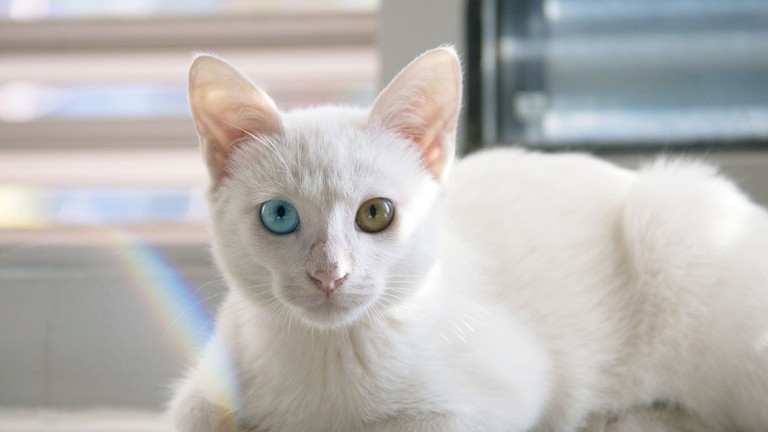
The Khao Manee cat also known as the Diamond Eye cat is a rare breed of cat originating in Thailand, which has an ancient ancestry tracing back hundreds of years. They are mentioned in the Tamra Maew, or Cat Book Poems. Khao Manee cats are pure white with a short, smooth, close-lying coat. They can have blue eyes, gold eyes or odd-eyes with one of each colour. The odd-eyed Khao Manee is the rarest variety. They are muscular, athletic cats of moderate foreign type and are reputed to be active, communicative and intelligent.
Although the breed is well known in its native land it has only recently been adopted by Western cat breeders, gaining “registration only” status from TICA in May 2009. On 3 September 2011, the breed was promoted to “Preliminary New Breed”, effective from 1 May 2012, and on 30 August 2013, the breed was promoted to “Advanced New Breed”, effective immediately.
On January 24, 2015, the Khao Manee breed was advanced to Championship level in TICA, effective May 1, 2015.
On 8 September 2010, at the meeting of the GCCF Executive Committee, the Khao Manee was granted breed name in GCCF, and was approved for exhibition only. The Khao Manee Cat Club was granted GCCF pre-affiliation at the Council meeting on 26 October 2011.
The breed has now gained acceptance also in CFA on February 7th, 2018, and has been welcome in their shows from May 1st, 2018. The CFA is the World Largest Registry of Pedigreed Cats and this new achievement is placing now the breed as globally recognized.
Korat
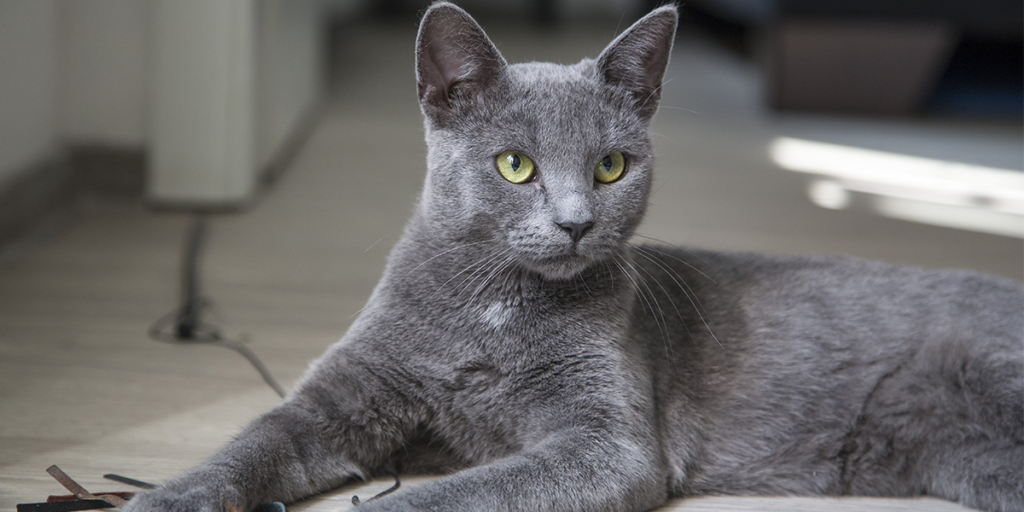
The Korat cat is a silver-tipped blue-grey, short-haired breed of domestic cat with a small to medium build and a low percentage of body fat. Its body is semi-cobby, and unusually heavy for its size. It is an intelligent and playful active cat that forms strong bonds with people. Among the Korat’s distinguishing characteristics are its heart-shaped head and large green eyes.
The Korat is a natural breed, and one of the oldest stable cat breeds. Originating in Phimai, Thailand, it is named after its province of origin, Nakhon Ratchasima Province (typically called “Korat” by the Thai people). In Thailand, the breed is known as Si sawat, meaning “colour of the sawat seed”. The Korat is known colloquially as the “good luck cat”. Traditionally, they are given in pairs to newlyweds or people who are highly esteemed, for good luck. Until recently, Korats were not sold, but only given as gifts.
The Korat’s unusual colour is actually a silver-tipped blue that appears to shimmer. The Thais refer to this colour as “rain-cloud grey”, and the shimmer as “sea foam”. This cat has a single coat that is short, with roots of a lighter silver blue. The hair shaft colour increases to a deeper blue and the tips are silver, especially on the muzzle and toes. This is the only colour accepted for a Korat. The eyes are large and peridot green in an adult cat, but kittens have muddy, amber or golden-green coloured eyes which gradually change as they become adults, at two to four years.
Although it is rare, Korats occasionally have striking or faint white markings or spots or even very faint grey stripes. Sometimes these spots increase in size with age. These are seen as flaws, and the cats are disqualified from competing in cat shows. However, such markings have no effect on personality or health.
Mekong Bobtail
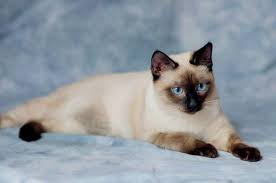
The Mekong Bobtail (formerly known as the Thai Bobtail) is a breed of cat. Originally named for Thailand, the country of origin of its progenitors, the breed is now named after the Mekong River. It is naturally distributed throughout parts of Asia and was developed as a breed in Russia, and it was recognised by the World Cat Federation in 2004.
In the 19th century, Mekong Bobtails were among the royal cats given to Russian emperor Nicholas II by Chulalongkorn, king of Siam. The majority of the 200 royal cats gifted by Chulalongkorn had kinked tails resembling those of the modern-day Mekong Bobtail. Other bobtail cats from Southeast Asia were also imported into Russia. The breed is considered to have been developed in Russia and continued to be experimentally developed there, being bred with other bobtail cats, and possibly also with Siamese cats. The breed started to become more widely known in the 1980s, and in December 1994 a breed standard was drawn up by O. S. Mironova, a Russian felinologist. The breed was recognised by the World Cat Federation in August 2004, and at that time its name was changed from “Thai Bobtail” to “Mekong Bobtail”.
Siamese cat
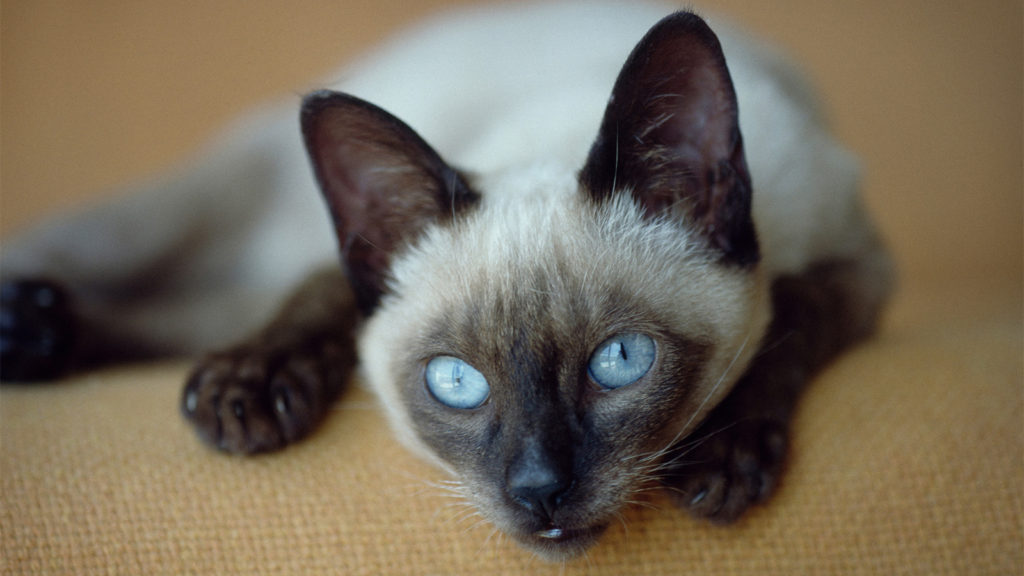
The Siamese cat is one of the first distinctly recognized breeds of Asian cat. Derived from the Wichianmat landrace, one of several varieties of cat native to China and brought to Thailand (formerly known as Siam), the original Siamese became one of the most popular breeds in Europe and North America in the 19th century. The carefully refined, more extreme-featured, modern-style Siamese is characterized by blue almond-shaped eyes; a triangular head shape; large ears; an elongated, slender, and muscular body; and various forms of point colouration. Other than colouration, the modern-style Siamese bears little resemblance to the original stock, and the more moderate, traditional, or “old-style” Siamese, with a much rounder head and body, has been re-established by multiple registries as the Thai cat. The International Cat Association describes the modern Siamese as affectionate, social, intelligent, and playful into adulthood, often enjoying a game of fetch. Siamese tends to seek human interaction and also like companionship from other cats.
The Siamese (sometimes in the traditional form) is among the foundation stock of several other breeds developed by crossbreeding with other cats; some examples are the Oriental Shorthair and Colourpoint Shorthair, developed to expand the range of coat patterns; the long-haired variant most often dubbed the Himalayan; and hair-mutation breeds, including the Cornish Rex, Sphynx, Peterbald, and blue-point Siamese cat. The Siamese cat comes in two distinct variations: traditional, with an apple-shaped head and a slightly chubby body; or the modern Siamese, which is very skinny and have a wedge-shaped head. The long-haired Siamese is recognized internationally as a Balinese cat. Siamese cats are one of the more common breeds to have different coloured irises.
Suphalak
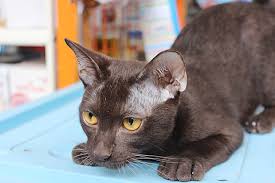
The Suphalak: Maew Suphalak, Maew Thong Daeng) is a solid reddish-brown copper-coloured short-haired breed of cat originating in Thailand. The Suphalak is a natural breed and should not be confused with the sable Burmese cat, an established American and European created breed which expresses the colourpoint Burmese gene (CB) that results in dark points on the extremities such as the ears, feet and tail as well as a dark mask on the face. A written description and pictorial of the Suphalak first appeared in the ancient Thai manuscripts (written by Buddhist monks) over 300 years ago known as the Tamra Maew.
Both a description and depiction of the Suphalak first appear in a collection of ancient manuscripts called the Tamra Maew (the Cat-Book Poems) thought to originate from the Ayutthaya Kingdom (AD 1351 to 1767). Over a dozen are now kept in the National Library of Thailand, while others have resurfaced outside of Thailand and are now in the British Library. and the National Library of Australia. In addition to the Suphalak, the Tamra Maew also describes other heritage cats of Thailand, including the Wichien Maat (a seal point Siamese with pale blue eyes) and the Korat, which are still bred for preservation in Thailand today and have become popular in other countries.
When the capital city of Ayutthaya was sacked on 7 April 1767 at the end of the Burmese-Siamese War, the Burmese army burned everything in sight and returned to Burma taking Siamese noblemen and royal family members with them as captives. Buddha images were hacked apart for their gold, and all the royal treasures were stolen. A Thai legend has it that the Burmese King Hsinbyushin found and read the poem for the Suphalak in the Tamra Maew. The poem describes the Suphalak as being as rare as gold, and anyone that owns this cat will become wealthy. He told his army to round up all the Suphalak cats and bring them back to Burma along with the other treasures. Today in Thailand this legend is told as a humorous explanation as to why the Suphalak is so rare.
Thai cat
The Thai or Wichien Maat : wichianmat, meaning ‘diamond gold’) is a newly renamed but old cat breed, related to but distinct from the Western, modern-style Siamese cat. This natural breed is descended from the cats of Thailand, and, among various groups of breeders in different times and places has also been called the Old-Style Siamese, Traditional Siamese, Classic Siamese; Wichien Maat (anglicised from the Thai name); and the Applehead, a nickname that originated in the 1950s (originally as a pejorative used by breeders of the modern-style, more extreme-featured Siamese). According to The International Cat Association: “The Thai is the breed dedicated to preserving the native pointed cat of Thailand in as close to its original form as possible.”
Compared to the modern-style, more extreme-featured Siamese, the traditional Thai breed (and native wichienmaat specimens) have a much more moderate appearance.
Thai Lilac
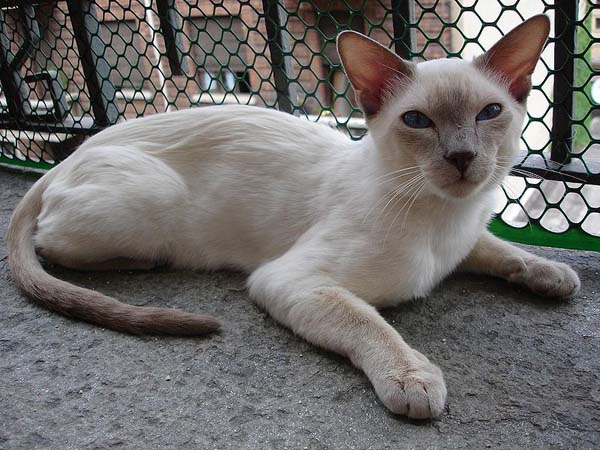
The Thai Lilac is a natural cat breed cat, which means they developed without the need for human intervention. These felines are known for being sociable, talkative, and playful.
As you may guess from the name, Thai Lilacs come from Thailand. The “lilac” part of the breed’s name refers to their coat color. You may find them in shelters and rescues, so remember to always adopt! Don’t shop if you’re looking to add one of these kitties to your home!
On a day-to-day basis, this breed behaves almost the same as the related Korat cat–which means they’re very people-focused felines who love to be around humans. If you want a sweet cat who’s affectionate with just about everybody, this may be your new best friend.
See all Thai Lilac cat breed characteristics below!